
Support Team
Feedback:
support@nextpcb.comWhen starting a new project, you might want to consider a field programmable gate array (FPGA) for your application. The two most popular choices for FPGAs are Xilinx (AMD) and Altera (Intel).
We enjoy having feuds, don't we? Coke vs. Pepsi, Nike vs. Adidas, Microsoft vs. Apple, iOS vs. Android, and the list goes on and on... When two capable rivals face off and achieve a level of parity, we get the makings of an aficionado, ideology, moniker, and personal vendetta spat. In the FPGA industry, that rivalry is between Xilinx and Altera. But how do you know which FPGA you should use? In this blog post, we will talk about the differences between the two, Xilinx vs Altera FPGAs.
Altera and Xilinx are two of the leading names in the FPGA world. For the past three decades, these two companies have been locked in fierce competition for leadership in the FPGA market. Xilinx is one of the first players and is currently the biggest name in the FPGA world. They have an estimated total logic market of $57 billion. Xilinx was the first to introduce FPGAs, leading to the first epoch of market expansion, and pioneering the age of invention, expansion, and innovation. While Altera, coming in at a close second, has adopted a strategy to expand the use cases of FPGAs. They have included dedicated tools, allowing arbitrary logic designs to be mapped and loaded into FPGA arrays in seconds to hours, while the physical loading into the array can be done within tens of milliseconds.
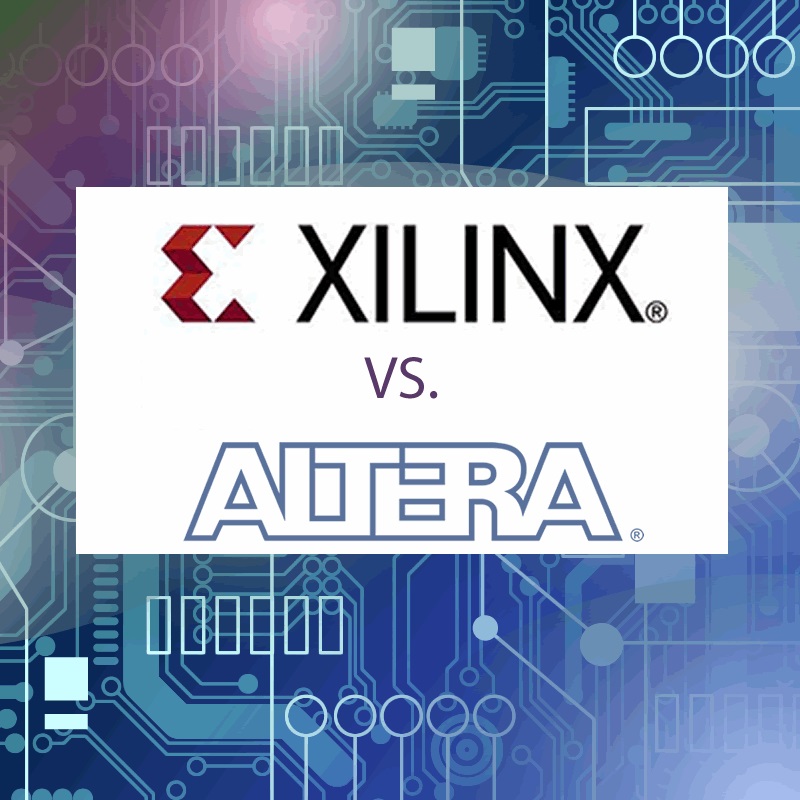
One of the main distinctions between the two FPGA boards lies in their approach and logic unit structure. Altera makes use of programmable clock tree synthesis rather than the direct approach followed by Xilinx. Xilinx boards are preferable for general logic as their designs are primarily for application development. On the other hand, Altera boards are geared toward industrial purposes and are more suitable for number crunching. Altera's FPGAs are more tailored toward system-on-chip designs, while Xilinx's focus is more on programmable logic.
In terms of performance, Intel has recently ramped up its FPGA battle with Xilinx, claiming a 40% performance improvement in its Agilex development. Intel's recent acquisition of Altera has given the latter an edge in the accelerator market due to its price and integration with Intel's Xeon.
In terms of architecture, Altera's FPGA products are more amenable to subtle optimizations. They have won the business on price and integration with Xeons in the accelerator market due to its new ownership by Intel. Furthermore, in terms of process nodes, Altera has won at 40/45nm while Xilinx has won at 28nm and 20nm.
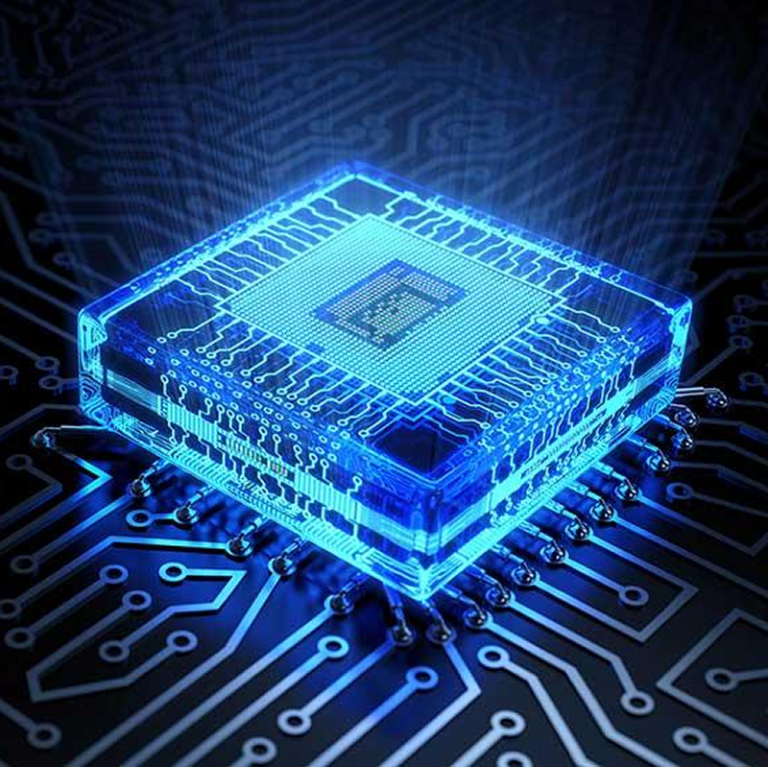
The rivalry between Altera and Xilinx has been ongoing for decades. Both companies continue to strive for innovation in the FPGA market. The table below lists comparable devices from Altera and Xilinx. You may find it useful as a starting point for converting from Xilinx to Altera and vice versa.
FPGA Device Family Comparison:
| Application | Xilinx* Devices | IntelR Devices |
|---|---|---|
| Highest performance |
Versal* Prime Versal* Premium |
Intel® Agilex™ F-Series Intel® Agilex™ I-Series |
| High performance |
Virtex* UltraScale+* Kintex* UltraScale+* Xynq* UltraScale+* |
Intel® Agilex™ F-Series Intel® Agilex™ I-Series Intel® Stratix® 10 GX Intel® Stratix® 10 SX Intel® Stratix® 10 TX Intel® Stratix® 10 MX Intel® Stratix® 10 DX |
| Mid-range |
Virtex* UltraScale* Kintex* UltraScale* Zynq* -7000 |
Intel® Stratix® 10 GX Intel® Stratix® 10 SX Intel® Stratix® 10 TX Intel® Stratix® 10 MX Intel® Stratix® 10 DX Intel® Arria® 10 GX Intel® Arria® 10 SX |
| Low cost | Artix* -7 | Intel® Cyclone® 10GX |
These two companies provide high-end FPGA families. When it comes to comparing the high-end FPGA series of Altera and Xilinx, both companies have their own advantages and disadvantages. Let us take a closer look at the most popular high-end FPGAs from Xilinx (AMD) and Altera (Intel) in the same category: ZCU11EG vs SX650.
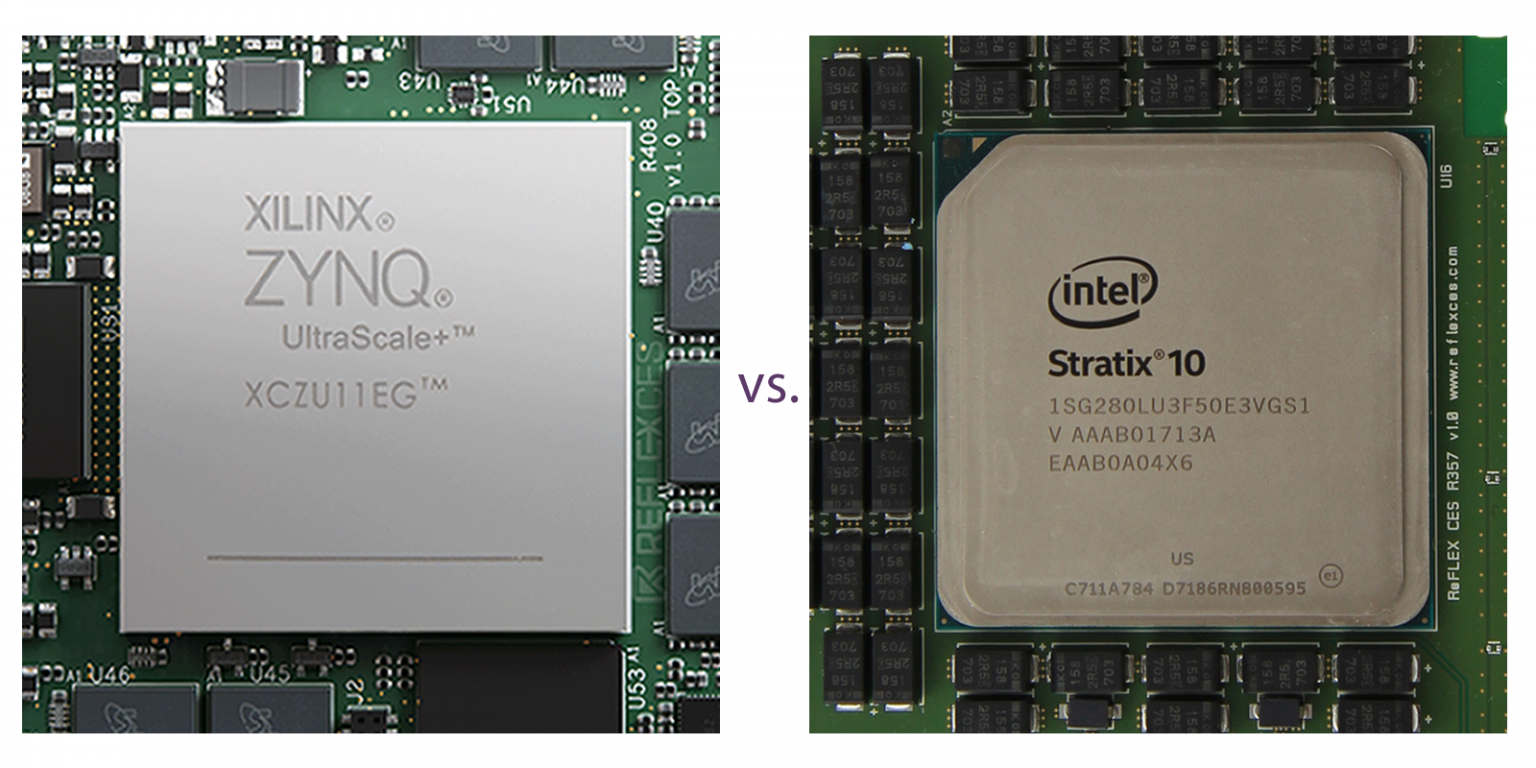
The key differences between the Xilinx ZU11EG and Altera Stratix 10 SX650 series FPGAs are in their logic elements, onboard RAM, multipliers, clocking structure, development tools, and simulation environment.
Both devices have dedicated high-speed carry logic for arithmetic functions and dedicated storage elements that can be configured as flip-flops or latches with flexible control signals. In terms of multipliers, Altera's device has a larger array of RF & 5G IPs as well as floating-point arithmetic support.
Altera Stratix 10 SX650 series is the better choice for 5G, RF, or image processing-based systems due to its large array of RF & 5G IPs, as well as its support for floating-point arithmetic. Xilinx's devices are better suited for video protocol implementations and fixed data manipulation due to their advanced routing network and better concept-to-market time.
You may notice that Xilinx has slightly better performance but lags behind in terms of design tools. Altera has better design tools but then slightly trades off on performance.
However, both FPGAs have marked special positions in different streams. Xilinx SoC typically being used in end products, while Altera specializes in image processing. The biggest difference between the two companies is their logic unit, with Xilinx's being more compelling than Altera's.
A comparison of the two FPGAs with ASICs also reveals some interesting points, with both sides possessing unique strengths. For instance, Altera FPGAs generally offer higher performance, but require more power than ASICs, while Xilinx FPGAs are more power efficient. Furthermore, Altera's Intel Agilex FPGA is known to have achieved 30% to 50% higher performance and 2x performance per watt than Xilinx Versal, making it a leader in innovation and setting it apart from Xilinx in this comparison.
Overall, both Xilinx and Altera's high-end FPGA families provide a wide range of features and performance levels that make them suitable for a variety of applications. The device you select should still be based on the requirements of your project.
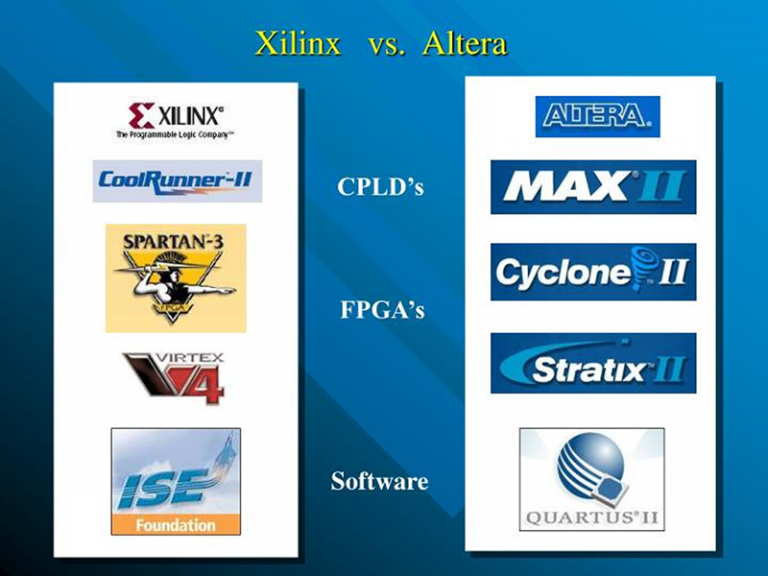
When it comes to features, Xilinx and Altera FPGAs both have their own unique advantages and disadvantages. They can both have benefits and drawbacks, with each having its own quirks in terms of how the tools function and programming styles. There are many ways to compare, but still, your choice boils down to your project's specific requirements. Let us explore the common ones.
The primary distinction between Xilinx and Altera FPGA is in how IP blocks communicate. Altera's proprietary communication protocol known as Protocol-Level Interconnect (PLI) is the traditional method of communicating with IP blocks between devices. Altera's PLI enables direct and efficient communication between IP blocks. The IEEE 1394 interface is used by the Xilinx series FPGA boards. It is an open, industry-standard protocol that is supported by all FPGA devices.
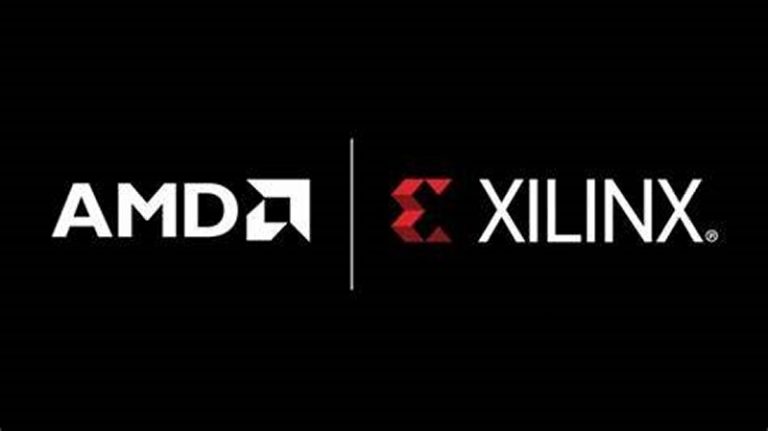
Xilinx FPGAs have many advantages over Altera FPGAs. Xilinx's short-term resources are very rich, which means that there is a high success rate of wiring when implementing logic. They also have dual-port RAMs, which make it easier to implement real dual-port RAMs. In addition, Xilinx FPGAs have several blocks of RAM, each 36KB, and the size of the RAM is flexible and configurable. They also have up to 12 phase-locked loops (PLL) and 48 independent system clocks.
The Xilinx series FPGA boards come with a free software development kit (SDK) and programmable logic design tools such as Altium Designer and Quartus II. The Altera series FPGA boards do not come with these additional software programs.
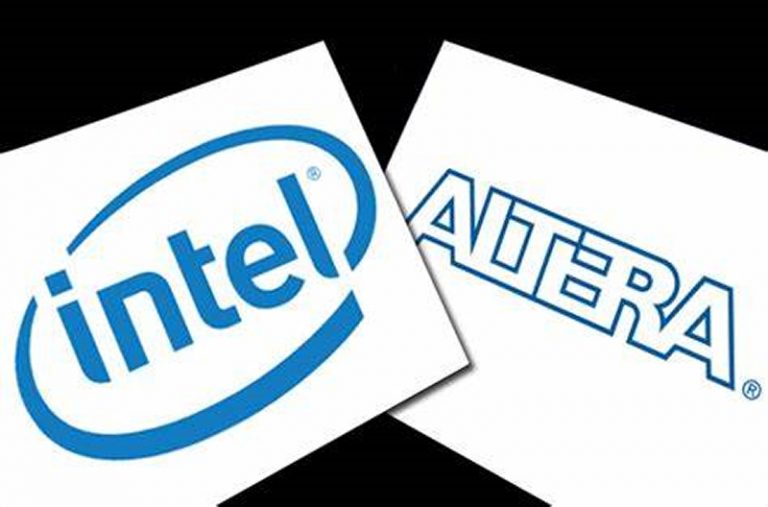
Altera FPGAs have some advantages over Xilinx FPGAs. Firstly, the Altera series has many improvements over the Xilinx series. Secondly, their products are generally cheaper due to their fewer resources. Third, their logic array module (LAB) contains 8 adaptive logic modules (ALM), which include two programmable registers, two dedicated full adders, a carry chain, a shared arithmetic chain, and a register chain. Additionally, they have a TriMatrix memory structure which includes 3 kinds of sizes of embedded RAM blocks for increased flexibility.
When deciding between Xilinx and Altera, one should first consider the tools available. Altera provides a free IDE with a logic analyzer, while Xilinx is more focused on FPGA and processor integration. Altera also offers FPGA chips and SoCs, while Xilinx specializes in programmable logic devices. It is important to understand the basics of digital logic when working with FPGAs. A course or at least thorough knowledge of this subject would be helpful.
It is clear that both Xilinx and Altera offer powerful and reliable FPGA products. Xilinx is suitable for those interested in processor and FPGA integration, while Altera is better for discrete logic applications. To get the most out of these FPGAs, those who are seriously interested in learning how to program FPGAs should consider taking a basic course in digital, focusing on discrete logic and familiarizing themselves with Intel Altera's Quartus Prime Development Suite.
Additionally, Intel's acquisition of Altera has been successful, and Intel's Webpack version 14.7 is preferred for simulation and synthesis. One should be able to implement a practical design on Xilinx hardware. He/she should also be able to debug a design on Xilinx hardware and understand the standard FPGA design flow.
Ultimately, it is up to the individual to decide which platform they want to learn. Still, with the tools available, either Xilinx or Altera should be suitable for those with a software engineering background.
Xilinx and Altera are two of the most prominent FPGA manufacturers in the market and are both renowned for their high-performance FPGA families.
The Xilinx vs. Altera FPGA performance comparison has been tested through benchmarking methodology, which is provided by Altera. This comparison has revealed that Intel Agilex FPGA achieved up to 30-50% higher performance and 2x performance per watt than Xilinx Versal. In addition, Intel leads in terms of innovation due to its Power Benchmark: Traffic Manager in 100G Line Card. Xilinx FPGA was chosen for its smaller size, meaning the P&R algorithm must work harder to reach the desired frequency due to limited space.
A twofold increase in power efficiency is a significant improvement, particularly on edge devices. Would anyone purchase a Xilinx Versal product when Intel Agilex provides twice the performance per watt? The context, according to Deepali Trehan, Vice President of Intel's Programmable Solutions Group, is that Xilinx has a large market share in FPGAs, so one would expect Xilinx to be smaller if it offered half the performance per watt. It is not a definitive answer, though, the basis on market share and delta scale, as this appears to be a very narrow and specific claim being highlighted, so one may take it with a grain of salt.
In terms of power benchmark, Xilinx's Virtex-7 X690T FPGA achieved superior performance compared to Altera's Early Power Estimator (EPE). Overall, Xilinx and Altera provide different levels of performance and design tools which makes them ideal for different applications. Hence, it is wise to consider all aspects of the project. Let us take a look at the following example.
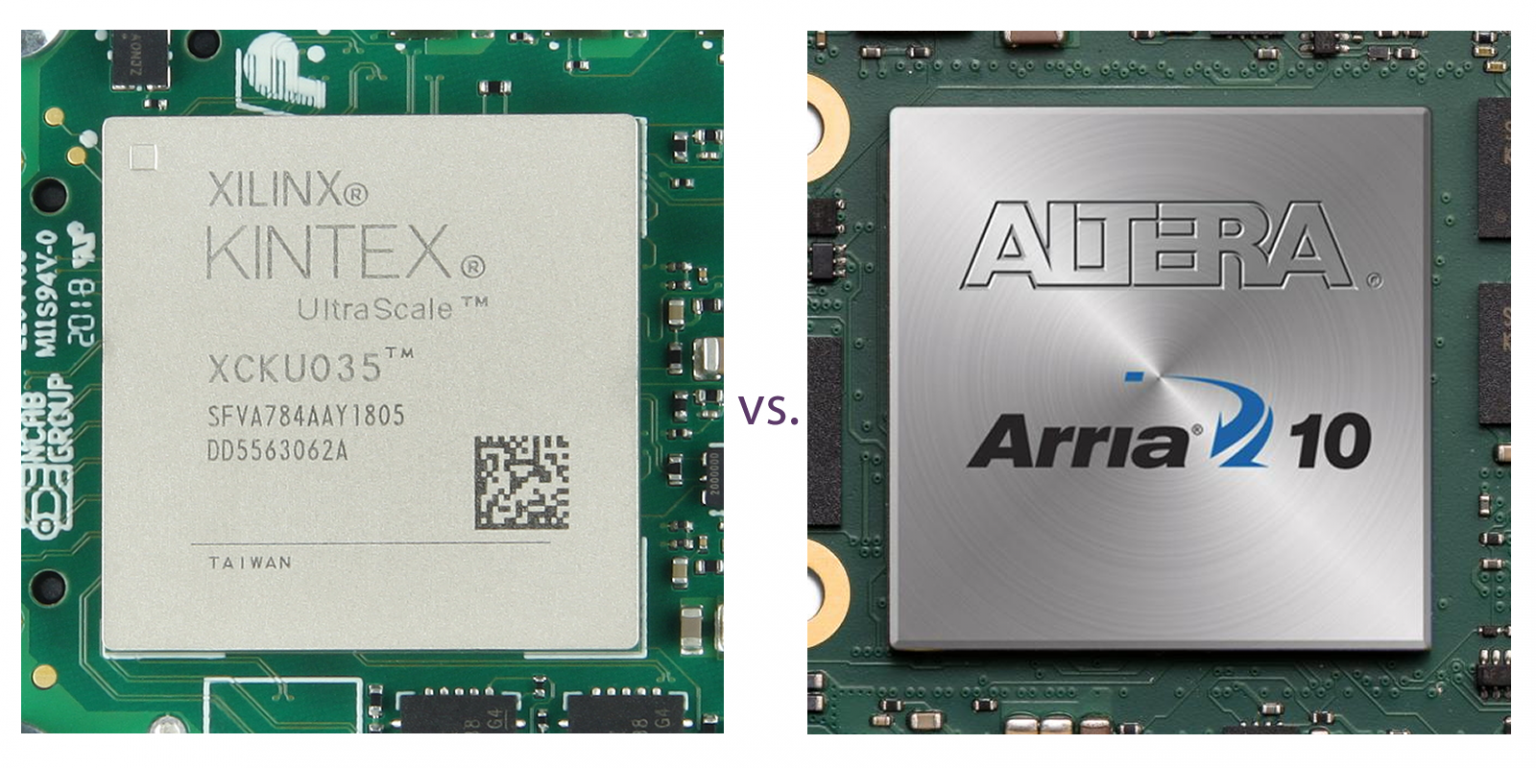
As an example, let us examine how Intel ARRIA 10 GX480 F35 and Xilinx UltraScale KU035 A1156 perform in comparison to each other.
The results of the comparison showed that Xilinx had a 20% faster compilation time. It has a more stable and higher frequency, with almost 50% less power consumption, and an 86% utilization ratio compared to Intel.
Even when comparing Intel's GX320 to Xilinx's KU035, Xilinx performs better in all cases. Considering the above data, given that the cost and the engineer's skills are factored in, Xilinx is the better choice for the project's requirements.
Xilinx and Altera are two leading manufacturers of Field Programmable Gate Array (FPGA) chips, offering a wide range of products that cost from a few to several thousand dollars.
Xilinx's least expensive FPGA chips are available in the market for around $8, while Altera's lower-end chips typically cost $12. However, the Virtex 7 FPGA from Xilinx is considerably more expensive at almost $40,000 per unit. In consideration of the high price, this is still quite cheap in comparison to other FPGA chips. Xilinx is mainly focused on applications and has boards with 192Gb of aggregate bandwidth. On the other hand, Altera is better known for its cost-sensitive applications and integration with Xeons in the accelerator market due to its ownership by Intel. Altera's Artix UltraScale family provides high I/O and high DSP compute FPGAs, with up to 192Gb of aggregate bandwidth, making it an excellent feature.
Despite the difference in cost, both Xilinx and Altera offer excellent features at competitive prices. They offer different advantages depending on the application, making them both great choices for cost-sensitive applications.
FPGAs are integral to many of the most advanced applications in electronics. For the past three decades, Xilinx and Altera have been engaged in a spirited rivalry to establish the leading position in FPGAs. These two leading FPGA vendors offer a range of devices to suit different needs. Before you go out and buy a new FPGA, you need to understand the differences that exist between them.
Xilinx is more focused on the processor and FPGA integration, while Altera's FPGAs are well-suitable for system-on-chip designs. In terms of architecture, Xilinx's logic unit relies on a direct approach, while Altera makes use of programmable clock tree synthesis. With regard to software tools, one may find Altera's GUI easier to work with than Xilinx's ISE. Xilinx has a more elaborate GUI suitable for experienced users.
Although both Xilinx and Altera have their own advantages and disadvantages, we can safely say that their FPGA products are of equally high quality. When it comes to a head-to-head comparison, both vendors offer highly competitive products and services, that can accommodate different needs, making it difficult to pick just one. The comparison between these two is technically not as simple as nailing down the capabilities of FPGAs to a single number, where the engineer(s) skills should also be considered. Ultimately, it really depends on the application for which one is best suited, as they are both relatively similar in features.
Still, need help? Contact Us: support@nextpcb.com
Need a PCB or PCBA quote? Quote now